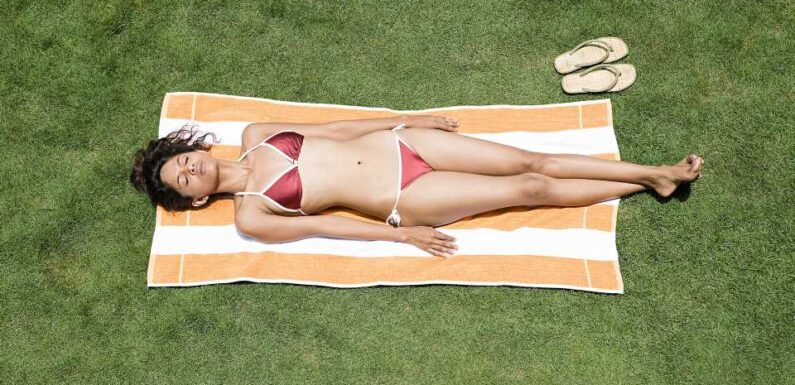
DESPITE summers getting hotter year after year and the potential health risks associated with it, many of us still love nothing more than sunbathing.
But how long does it take to tan, and can you get a tan in the shade or when using SPF 50 sun screen?
How long does it take to tan in the sun?
British dermatologists say people in the UK have an unhealthy relationship with tanning.
Even though they are aware of the risks of sun exposure, many people choose not to change their behaviour.
Getting the perfect tan takes a while for most people (while some are lucky to go golden in just a day).
Everyone has different skin which means everyone’s tanning time will vary.
READ MORE ON TANNING

Paul Hollywood is so obsessed with sunbathing he strips off during filming

I bought the viral ‘tan through’ bikini, it’s see-through & gives awks tan lines
Some people may gain colour from the sun in a few hours and others tend to burn if they sunbathe for the same amount of time.
The main way to judge roughly how long it will take is by knowing your skin tone.
Melanin is a pigment that influences your skin colour, as well as eyes and hair.
People with less melanin have fairer skin which burns more easily, and may do better sunbathing in short bursts.
MOST READ IN HEALTH

How to find out how much you have cost the NHS

Bruce Willis’ wife breaks down as she gives an update his dementia struggle

From irregular periods to bowel problems, Dr Jeff answers your health questions

From arthritis to extreme neck pain – Dr Jeff answers your health questions
On the other hand, if you have more melanin in your skin, you can get a darker colour in a matter of minutes or hours.
Regardless of your skin tone, you should wear SPF because it protects the skin from DNA damage, which leads to cancer, caused by UV (ultraviolet) rays.
The Skin Cancer Foundation says: "Men, women and children over six months of age should use sunscreen every day.
"This includes people who tan easily and those who don’t — remember, your skin is damaged by sun exposure over your lifetime, whether or not you burn."
Can you still tan using SPF50?
The simple answer is yes, you can still tan using every SPF factor whether it is 15, 30 or 50+.
The way SPF works is that sunscreen acts as a barrier so that only a certain amount of UV gets through to your skin.
SPF impacts your ability to tan, so will take you longer for your skin colour to change, but remember you are protecting your health and preventing deadly disease.
An SPF of 30 filters out 96.7 per cent of UV rays, while and SPF of 50 filters out 98 per cent – there isn’t a sunscreen than can guarantee 100 per cent protection.
ABC Australia reported if your unprotected skin would take 10 minutes to show signs of burning, then properly applying factor 50 would make the rate of burning 50 times longer (so 500 minutes/more than eight hours).
Factor 30 would be 30 minutes longer (300 minutes/five hours); and factor 15 would be therefore take 150 minutes (an hour and a half) longer to show signs of burning.
But in the real world, you'll likely burn if you don't reapply your sun cream repeatedly for hours on end.
It is advisable to top-up your sun cream every couple of hours when in the sun.
You should also reapply after you have been in water, even if your sunscreen is "water resistant", after towel drying, sweating and when it may have rubbed off.
Can I get a tan in the shade?
Yes, tanning in the shade is possible.
The sun reflects off objects in the environment and on to skin.
Certain environmental factors such as bright snow or pale beach sand can reflect the sun’s rays to your skin, even while sitting in the shade.
For example, experts from Queensland University of Technology said sand can reflect as much as 25 per cent of UV radiation.
That's why the professionals at skincancer.org have said while shade is a potentially valuable means of protection from the damaging effects of the sun’s UV rays, not all shade is equally protective.
They also go on to say people can spend long hours in the shade while still receiving quite a lot of sun exposure and risking skin damage.
UVB rays, often considered the most harmful part of sunlight, can reach the skin indirectly.
So even if you're not directly in the sun, you still need to wear a sunscreen with an SPF factor in it, even when you are not actively tanning.
See our expert's top tips for getting the perfect tan safely.
Source: Read Full Article
